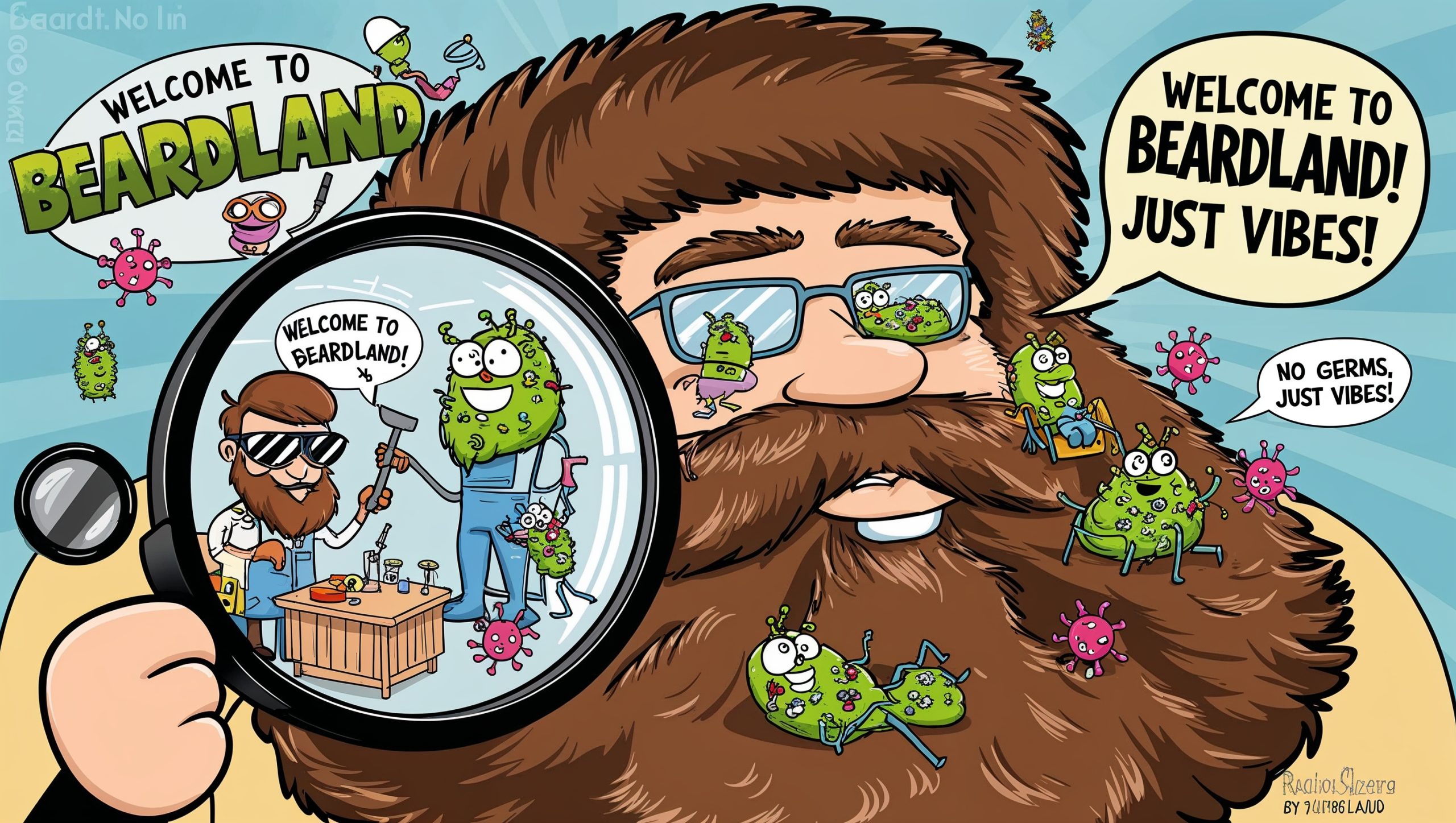
- The science behind bacteria and beards
- Common misconceptions about beards and bacteria
- Studies on the bacterial content of beards
- Factors that influence beard bacteria levels
- The benefits of having a beard
- How to properly clean and maintain a beard
- Debunking myths about beard hygiene
- Tips for maintaining a healthy beard
- Conclusion: The final verdict on beards and bacteria
Are beards really a breeding ground for bacteria? This question has sparked a heated debate in recent years, with some claiming that beards are dirty and unhygienic, while others argue that they offer a natural defense against harmful bacteria. In this article, we delve deep into the relationship between beards and bacteria to unmask the truth.
While it is true that bacteria naturally resides on our skin, regardless of whether we have facial hair or not, the unique structure of a beard can potentially provide a favorable environment for bacteria to thrive. The dense nature of facial hair can trap dirt, oil, and food particles, creating a breeding ground for bacteria. However, research suggests that the presence of bacteria on beards does not necessarily equate to a higher risk of infections or diseases.
We will explore scientific studies and expert opinions to understand the true impact of beards on bacterial growth and overall hygiene. So, whether you’re a proud bearded individual or someone considering growing a beard, this article will provide you with evidence-based insights on the relationship between beards and bacteria. Get ready to separate fact from fiction and uncover the truth about facial hair hygiene.

The science behind bacteria and beards
Bacteria are microscopic organisms that thrive in various environments, including our skin and hair. It is essential to understand that bacteria are not inherently harmful; in fact, many types of bacteria are beneficial and play a crucial role in maintaining our skin health. The human body hosts a diverse microbiome, which includes different bacterial species that help protect against pathogens and maintain skin integrity. When it comes to beards, the structure and density of facial hair can create a unique environment for these microorganisms to flourish.
The design of a beard, with its intricate network of hair strands, can trap moisture, oils, and even food particles that we may unknowingly leave behind. This environment can be conducive to bacterial growth. Research indicates that the warm and humid conditions often found in the beard area can lead to an increase in bacterial colonies. However, it is crucial to differentiate between types of bacteria; not all bacteria are harmful, and many are part of our natural skin flora. Understanding this distinction is vital when assessing the hygiene of beards and their relationship with bacteria.
Additionally, the interaction between our skin and bacteria is complex. The skin’s surface is continuously shedding dead cells, which can also serve as a food source for certain bacteria. This cycle creates a dynamic ecosystem on our skin and facial hair. While beards may collect bacteria, they also host beneficial microorganisms that can aid in the skin’s overall health. Thus, a beard is not merely a collection of hair; it is an ecosystem that requires understanding and care to ensure it remains healthy and balanced.

Common misconceptions about beards and bacteria
One of the most prevalent misconceptions is that beards are universally dirty and a breeding ground for harmful bacteria. This stereotype often stems from visual associations between unkempt beards and poor hygiene. However, it is essential to recognize that hygiene practices play a critical role in the cleanliness of any facial hair. Just as hair on the scalp can be kept clean with regular washing, beards can also be maintained through proper grooming techniques. The idea that all bearded individuals neglect their hygiene is not only unfounded but also unfair.
Another misconception is that beards inherently harbor more bacteria than clean-shaven faces. While studies might show varying levels of bacterial presence in beards, it does not automatically imply that beards are less hygienic. In fact, some studies have suggested that individuals with well-groomed beards may have similar or even lower levels of harmful bacteria compared to those who are clean-shaven. This phenomenon can be attributed to the fact that regular cleaning and maintenance can significantly reduce the bacterial load, making the presence of a beard not a determinant of hygiene.
Furthermore, there is a widespread belief that beards contribute to the spread of diseases, particularly respiratory infections. While it is true that bacteria can be transferred from one surface to another, the act of having a beard does not inherently increase the likelihood of illness. The transmission of bacteria largely depends on personal hygiene and environmental factors rather than the mere presence of facial hair. Understanding these misconceptions is crucial for fostering a more balanced view of beards and their relationship with bacteria.

The Bearded Rogue recommends this all-natural beard care set with Shea Butter, Aloe Vera, and Coconut Oil. It cleanses, hydrates, and softens facial hair, featuring outdoor-inspired scents like Sandalwood, Vetiver, and Mandarin. Paraben-free, cruelty-free, and made in the USA, this complete regimen soothes itchiness and promotes healthy, conditioned beards.
Studies on the bacterial content of beards
Several studies have aimed to investigate the bacterial content found in beards, providing valuable insights into this topic. One notable study conducted by researchers at the Hirslanden Clinic in Switzerland examined the bacterial flora present in the beards of men. The researchers discovered a variety of bacterial species, with some participants showing higher counts of potentially pathogenic bacteria. However, the majority of the bacteria found were not harmful and included strains that are commonly associated with healthy skin.
Another significant study published in the journal “European Journal of Clinical Microbiology & Infectious Diseases” highlighted the differences in bacterial communities between bearded and clean-shaven individuals. The findings indicated that while beards do contain bacteria, the composition of these bacterial communities can vary greatly. Interestingly, some bearded participants exhibited lower levels of harmful bacteria compared to their clean-shaven counterparts, suggesting that proper maintenance and hygiene practices can greatly influence the bacterial profile of facial hair.
Despite these findings, it is essential to approach the results with caution. The presence of bacteria does not equate to an increased risk of infection. Most bacteria are harmless and are part of the natural skin flora. The studies underscore the importance of context when interpreting the data, emphasizing that beards can host both beneficial and potentially harmful bacteria. Ultimately, the relationship between beards and bacteria is complex and requires a nuanced understanding to draw accurate conclusions.
Factors that influence beard bacteria levels
The bacterial content of beards can be influenced by various factors, including grooming habits, diet, and environmental conditions. Personal hygiene is perhaps the most significant factor; individuals who regularly clean and maintain their beards are likely to have lower levels of harmful bacteria. Incorporating a consistent washing routine with appropriate beard care products can help mitigate the accumulation of dirt, oil, and food particles that can harbor bacteria. Therefore, the decision to invest time in grooming can have a direct impact on the overall cleanliness of a beard.
Diet also plays a crucial role in determining the health of both the skin and beard. Foods rich in antioxidants, vitamins, and minerals can enhance skin health and promote a balanced microbiome. On the other hand, a diet high in processed foods and sugars may contribute to inflammation and imbalances within the skin’s ecosystem. This imbalance can potentially lead to an increase in pathogenic bacteria. Therefore, a well-rounded diet not only benefits overall health but also supports beard hygiene.
Environmental factors, such as exposure to pollutants, humidity, and temperature, can also influence beard bacteria levels. For instance, individuals living in urban areas may find their beards collecting more dirt and pollutants compared to those in rural settings. Additionally, humidity can create a more favorable environment for bacterial growth. Understanding these external influences can empower individuals to take proactive steps in maintaining their beard hygiene, such as washing more frequently in polluted environments or adjusting their grooming routine based on weather conditions.

The benefits of having a beard
Beyond the discussions surrounding bacteria, beards offer a plethora of benefits that extend beyond aesthetics. One of the most notable advantages is the protection they provide against environmental factors. Facial hair acts as a barrier against UV rays, reducing sun exposure on the skin underneath. This can help prevent sunburn and lower the risk of skin cancer. Furthermore, beards can shield the skin from harsh weather conditions, such as wind and cold, which can lead to dryness and irritation.
Beards may also have psychological benefits. Many men report feeling more confident and masculine with facial hair. The association between beards and maturity or wisdom can contribute to a more positive self-image. Additionally, beards can serve as a form of self-expression, allowing individuals to showcase their personal style and identity. This connection to confidence and self-expression can have a significant impact on mental well-being.
Moreover, beards can provide a surprising level of insulation. The hair itself traps heat, which can be beneficial in colder climates. This natural warmth can make a noticeable difference during chilly temperatures, keeping the face warmer than it would be without facial hair. Overall, the benefits of having a beard are multifaceted, encompassing protection, psychological enhancement, and even physical comfort, making them more than just a trend in grooming.

The Bearded Rogue recommends this all-natural beard care set with Shea Butter, Aloe Vera, and Coconut Oil. It cleanses, hydrates, and softens facial hair, featuring outdoor-inspired scents like Sandalwood, Vetiver, and Mandarin. Paraben-free, cruelty-free, and made in the USA, this complete regimen soothes itchiness and promotes healthy, conditioned beards.
How to properly clean and maintain a beard
Proper cleaning and maintenance are key to ensuring a healthy beard and minimizing any potential bacterial growth. The first step in beard care is to establish a regular washing routine. Using a gentle beard shampoo or cleanser specifically formulated for facial hair is advisable, as it helps remove dirt, oil, and debris without stripping the hair of its natural oils. Aim to wash your beard at least two to three times a week, or more frequently if you lead an active lifestyle or are exposed to pollutants.
After washing, conditioning the beard is equally important. A good beard conditioner helps soften the hair, making it more manageable and reducing the risk of irritation or itching. Conditioning also locks in moisture, promoting healthier hair growth and preventing dryness. Applying conditioner while in the shower allows it to penetrate the hair effectively. Consider leaving it on for a few minutes before rinsing to maximize its benefits.
Finally, regular grooming is essential for maintaining a tidy and healthy beard. This includes trimming to keep the shape and prevent split ends, as well as brushing or combing to distribute natural oils evenly. Additionally, using beard oils or balms can provide extra nourishment and hydration, helping to keep both the hair and underlying skin in optimal condition. By implementing these steps into your grooming routine, you can ensure that your beard remains clean, healthy, and free from excess bacteria.
Debunking myths about beard hygiene
The realm of beard hygiene is often clouded by myths and misconceptions that can lead to unnecessary stigma. One prevalent myth is that beards should never be washed, as some believe that this can strip the hair of its natural oils. In reality, washing is essential to remove trapped dirt and bacteria. While it’s important to use products designed for facial hair, regular cleansing is crucial for maintaining a healthy beard. The idea that beards are self-cleaning is misleading and can contribute to hygiene issues if individuals neglect proper care.
Another myth suggests that beards always smell bad and are a source of unpleasant odors. This notion often arises from the stereotype that bearded individuals are less likely to maintain good hygiene. However, just like any other part of the body, beards can emit odors if not cared for properly. Regular washing, conditioning, and the use of beard oils can help eliminate any potential smells. In fact, many beard care products are infused with pleasant fragrances, ensuring that beards can smell fresh and inviting.
Lastly, some believe that the longer the beard, the more bacteria it harbors. While it is true that longer beards can trap more debris, the overall bacterial content is influenced more by hygiene practices than length itself. A well-maintained long beard can be just as clean as a short one. Emphasizing proper care and maintenance is essential in debunking this myth and promoting a more positive view of beards and hygiene practices.

Tips for maintaining a healthy beard
To ensure your beard remains healthy, there are several practical tips that can be followed. First and foremost, invest in quality grooming products specifically designed for facial hair. This includes beard shampoo, conditioner, oils, and balms that cater to the unique needs of beards. These products are formulated to cleanse without stripping essential oils, hydrate the hair, and promote growth. Selecting the right products is essential for maintaining optimal beard health.
Another crucial aspect of beard maintenance is regular trimming. Even if you are growing your beard out, maintaining a well-groomed shape can prevent split ends and promote healthier growth. Investing in a good pair of scissors or a quality trimmer can help you achieve the desired length and style. Additionally, trimming can also help remove any dead or damaged hair, promoting a fuller and healthier appearance.
Finally, consider incorporating a healthy lifestyle into your routine. Proper nutrition, hydration, and exercise play a significant role in hair health. A diet rich in vitamins, minerals, and proteins can promote hair growth, while adequate hydration keeps both your skin and hair hydrated. Incorporating stress management techniques can also benefit beard health, as high stress levels can negatively impact hair growth. By following these tips, you’re not just maintaining your beard; you’re investing in your overall health and well-being.
Conclusion: The final verdict on beards and bacteria
In conclusion, the relationship between beards and bacteria is intricate and nuanced. While beards can harbor bacteria due to their unique structure and environment, the presence of these microorganisms does not inherently indicate poor hygiene or increased health risks. Proper grooming and maintenance practices can significantly mitigate any potential issues, allowing individuals to enjoy the benefits of facial hair without concern.
The evidence suggests that with appropriate care, beards can be just as clean as clean-shaven faces. Furthermore, the advantages of having a beard extend beyond aesthetics, encompassing protection from environmental factors, psychological benefits, and even insulation from cold weather.
Ultimately, embracing a beard can be a rewarding experience, provided individuals commit to maintaining proper hygiene and care. By separating fact from fiction and focusing on evidence-based practices, one can confidently navigate the world of beards and bacteria, enjoying all the benefits that facial hair has to offer while ensuring optimal health and hygiene.





One thought on “Unmasking the Truth: Exploring the Relationship Between Beards and Bacteria”